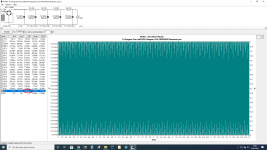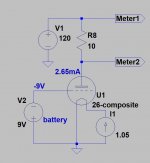In the vid, why does the meter show frequency less than 10 Hz? If it is AC ripple, it will be a multiple of 50 Hz, right? Maybe the meter should try to measure at 50 Hz or 100 Hz.
More importantly, do you hear hum? 800 mV of ripple will be audible.
More importantly, do you hear hum? 800 mV of ripple will be audible.
Try this using the meter: measure AC input voltage. Should be 220V or whatever is the voltage in your country (use extreme caution when doing this and read up on tube safety guides here and elsewhere). Then using the same setting on the meter, clip it to the output RCA. What do you measure? This is ultimately what goes out of the preamp. The gyrator has very good supply ripple rejection.
If you want to know what your PS is doing and compare to the sim, then clip it to the gyrator B+ input and see what it shows.
If you want to know what your PS is doing and compare to the sim, then clip it to the gyrator B+ input and see what it shows.
Both outputs RCA measuring same 0.9mVAC.
That's the reason of my post, see my vid showing what the PSU is doing.
That's the reason of my post, see my vid showing what the PSU is doing.
I have two valve with high difference in the anode current, one with 3mA & the other 6mA (bias set to 120V B+ and -9V), I'm using filament bias & want to know what's the best approach to match both 26?
1-The tube with anode-current high reducing the B+ to get 5mA & increase the B+ of the tube with anode-current low to 5mA.
2-Look for another tube to match same or similar anode-current.
TIA
1-The tube with anode-current high reducing the B+ to get 5mA & increase the B+ of the tube with anode-current low to 5mA.
2-Look for another tube to match same or similar anode-current.
TIA
What's the best jig, or both are ok?
R1 & R2 power rating?
P. S. I'm using bench PSU lab for filaments.
R1 & R2 power rating?
P. S. I'm using bench PSU lab for filaments.
Last edited:
Using the second is easier.
You can only set anode voltage, grid negative voltage, and measure voltage on 10R (proportional of anode current: 1mA results 10mV).
The dissipation on balancing resistors only few ten mW (in case of #26 tube).
You can only set anode voltage, grid negative voltage, and measure voltage on 10R (proportional of anode current: 1mA results 10mV).
The dissipation on balancing resistors only few ten mW (in case of #26 tube).
Used this one & works flawlessly, thanks Bela.
Why so difficult to find umbilical connectors?
For 10. 12 ... who really knows how many years? ... I've been using an umbilical from the preamp PSU to my preamp chassis consisting of octal plugs and sockets. It's been working all those years.
Best, Robert
For 10. 12 ... who really knows how many years? ... I've been using an umbilical from the preamp PSU to my preamp chassis consisting of octal plugs and sockets. It's been working all those years.
Best, Robert

Welcome!
You are here: Home
Notice:
After 20+ years as the US distributor of Lundahl transformers, I have decided to retire to focus my time on enjoying life with my family.Effective immediately, please contact Holger Schaarsmidt at erhardaudio@gmail.com for any transformer order inquiries.
It has been my pleasure getting to know all the great customers over the years! I will miss you all.
Kevin
Please contact us for any questions.
Sorry to report,
Best,
Robert
Hi Andy,I take the end bells off and mount them under the chassis. You just need the primaries. They're big and solid items.
Why take the end bells off of the Hammonds?
Robert
It was the advice of Bud Purvine, maker of O-Netics. He said transformers sounded better without end bells.Hi Andy,
Why take the end bells off of the Hammonds?
Robert
- Home
- Amplifiers
- Tubes / Valves
- #26 pre amp

![IMG_20220416_204412[1].jpg](/community/data/attachments/953/953477-1fbf13c409d00861d0fc5795686ec323.jpg?hash=H78TxAnQCG)
![IMG_20220416_204149[1].jpg](/community/data/attachments/953/953478-4b2b8853413d14e8da12a53849b422bc.jpg?hash=SyuIU0E9FO)


